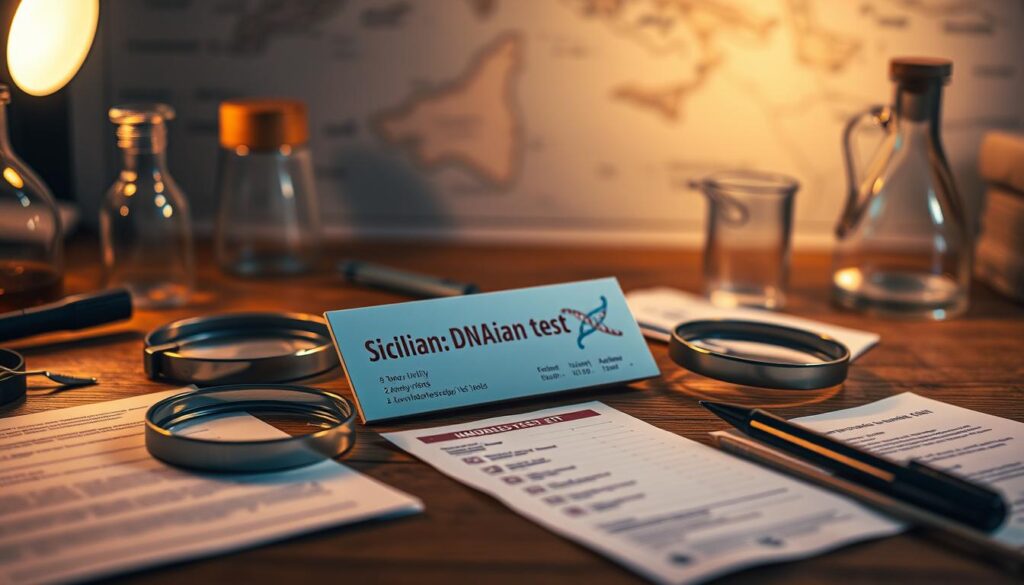Uncovering your Sicilian heritage is a deeply personal and rewarding experience. You’ll connect with your ancestors’ stories and gain a sense of identity. Sicily offers genealogical information dating back to the 16th century, including baptismal, marriage, and tax census records.
Picture discovering your great-grandparents’ names and stories in Sicily’s picturesque villages. You might find ancestors who were skilled craftsmen, scholars, or nobility. This journey helps you appreciate the sacrifices and triumphs that led to your existence.
Sicilian genealogy research is about more than gathering facts. It’s about connecting to your ancestral homeland and understanding your family’s history. This exploration can help shape your understanding of your family’s destiny.
Researching Sicilian ancestry can be challenging, with ancient records and language barriers. However, the rewards are immeasurable. Professional researchers, local guides, and online resources can help you explore your family history.
From Palermo’s busy streets to charming countryside villages, each step brings you closer to your roots. You’ll embrace the rich tapestry of your heritage and understand your family’s past.
Now’s the time to start your Sicilian family history adventure. With dedication and an open heart, you’ll uncover stories that shaped your family. You’ll gain pride in your Sicilian ancestry and celebrate your family’s incredible journey.
Understanding Sicilian History and Culture
Discovering your Sicilian heritage is a rewarding experience. It connects you with your ancestral roots. Sicily’s vibrant culture and complex past have been shaped by various civilizations over time.
This Mediterranean island blends unique traditions. Its distinctive way of life reflects a rich historical tapestry. Understanding Sicily’s past is key to appreciating your family’s history.
Sicily’s location has attracted many conquerors and settlers. Greeks, Romans, Byzantines, Arabs, Normans, and Spanish all left their mark. Their influence is seen in the island’s culture, architecture, cuisine, and language.
Diverse architectural styles dot Sicily’s landscape. You’ll find ancient Greek temples, Baroque churches, and Moorish palaces. These structures showcase the island’s varied cultural heritage.
Sicilian cuisine is a highlight of the island’s culture. It’s known for fresh ingredients and bold flavors. The food blends Mediterranean influences in unique ways.
Iconic dishes include Pasta alla Norma with eggplant and ricotta salata. Sweet and refreshing granita is another local favorite. These foods reflect Sicily’s agricultural wealth and culinary creativity.
“To know and understand Sicily is to grasp the essence of the Mediterranean itself.” – Tomasi di Lampedusa
Exploring your Sicilian roots may reveal fascinating ancestral stories. You might learn about their lives, challenges, and triumphs. Understanding their social and economic conditions provides context for your family’s history.
Sicilian cultural traditions are an important part of your heritage. They’ve shaped your identity and left a lasting legacy. Discovering these traditions deepens your connection to your Sicilian roots.
Importance of Genealogy Research
Exploring your Sicilian family tree connects you with your ancestral roots. It provides insights into your family’s past and historical events. Genealogy research preserves heritage and deepens your understanding of your identity.
Sicily offers an abundance of genealogical resources. Many Sicilians can trace their lineages to the sixteenth century. The island’s oldest records date back to around 1500.
This 500-year record preservation is exceptional in Europe. It makes Sicily invaluable for uncovering family history.
“To forget one’s ancestors is to be a brook without a source, a tree without a root.” – Chinese Proverb
A Sicilian family tree investigation satisfies personal curiosity. It also contributes to understanding Sicily’s rich history and culture. Exploring your ancestors’ lives deepens appreciation for their challenges and triumphs.
This knowledge can inspire pride and belonging. It strengthens your connection to your Sicilian heritage.
Starting Your Genealogy Journey
Tracing your Sicilian roots online can be exciting and rewarding. Start by gathering information from family members about names, dates, and locations. Organize your findings to determine which ancestors to research further.
Online resources like FamilySearch and Ancestors – Archives for Master Search offer digital records from Italian state archives. These platforms can help uncover valuable information about your Sicilian heritage. Researching Sicilian ancestry may take longer but often yields more comprehensive results.
Be aware of potential challenges when tracing Sicilian roots online. About 20% of Italian immigrants changed their surnames upon arrival in a new country. This can make research more difficult.
To overcome this, consider contacting others with common surnames or ancestry. This approach may boost your chances of genealogical success.
“The journey of a thousand miles begins with a single step.” – Lao Tzu
Explore various record types as you progress in your research. Naturalization records, passenger lists, and census reports can provide crucial information about your family history.
Try online genealogy platforms like Ancestry.com. You can set up an account and start searching for relatives quickly.
Essential Tools for Genealogy Research
Tracing Sicilian roots requires access to key genealogical resources in Sicily. FamilySearch offers millions of digitized Italian records. The National Archives holds the Italians to America Passenger Data File, indexing over 800,000 Italian passengers.
Church records in Italy date back to the 1500s. They provide continuous birth, marriage, and death information. Parrocchie.it helps locate churches and parishes for research.
Many Italian families have four centuries of genealogy in one parish. This is due to limited historical migration.
Italian civil record-keeping began with Napoleonic Civil Registration in 1806. The Restoration period lasted from 1815 to 1865. Uniform Italian Civil Registration records have been kept since 1866.
“A significant percentage of genealogically useful records were created at the local level, specifically town and parish records.”
The Portale Antenati provides access to civil registration and military records. Comuni-Italiani offers insights on Italy’s regions, provinces, and municipalities. CISEI has an online database for emigrants who left from Genova harbor.
Accessing Italian Vital Records
Italian vital records are crucial for tracing Sicilian ancestry. Birth, marriage, and death certificates help piece together family history. These records are available through local municipalities and provincial state archives.
Accessing these records may require appointments and specific procedures. Before 1906, naturalization could be done in various courts. After 1906, it was centralized in federal courts. The residency requirement was typically five years.
Pre-1906 records were less centralized, causing naming and documentation issues. Language barriers and manual record-keeping contributed to these discrepancies. Passenger lists from 1820 to 1957 can show ancestors’ last connection to Italy.
“The past is never dead. It’s not even past.” – William Faulkner
Researching Italian vital records uncovers valuable information about Sicilian heritage. It helps build a complete picture of your family tree. Exploring your ancestors’ rich history and culture is an exciting journey.
Utilizing Sicilian Civil Registries
Sicilian civil registry records offer valuable insights for tracing family roots. These records include births, marriages, and deaths from the early 19th century. They’re found in municipal and provincial state archives throughout Sicily.
Civil registration in Sicily began in 1820. This followed southern Italy’s trend, which started in 1809. These records can be incredibly helpful for genealogical research.

The Civil Registry in Enna maintains yearly and decadal origin indexes. Access to recent records may be limited due to privacy laws. Some records are only available at local civil registries.
Researchers can track digitization projects through the Ancestors Portal (Antenati). When requesting records, it’s best to write in Italian. Officials typically respond in their native language.
The process may require payment by cashier’s check or international money order. Persistence and patience are crucial when navigating the bureaucratic process. Obtaining these vital records can be challenging but rewarding.
“Discovering my grandfather’s American birth certificate was a breakthrough moment in our family history research. It not only revealed his birthplace but also his Italian citizenship, which opened up new avenues for exploration.”
Enna Province civil registry records can provide a wealth of information. This includes municipalities such as Agira, Aidone, and Assoro. Historical records may include French, German, or Latin languages.
Records created under foreign rule might use different languages. Church records often use Latin. Understanding these language variations can help in deciphering older documents.
Exploring Immigration and Naturalization Records
Tracing Sicilian ancestors’ journey to America is key for uncovering family history. Sicilian immigration and naturalization records offer valuable clues about an ancestor’s origins. These documents reveal their path to a new life in the United States.
Millions of Italians immigrated to various countries between 1880 and 1920. After the 1890s, most emigrants came from southern Italy, especially Sicily. Immigrants entered the US through ports like New York, Boston, Philadelphia, and New Orleans.
Several record types help trace Sicilian ancestry. These include passport applications, military conscriptions, and church records. Civil registrations, censuses, and naturalization papers are also useful.
About 30% of southern Italian immigrants returned to Italy within five years. Many Italian men, called “birds of passage,” made multiple trips before settling permanently. This pattern affected their records.
“Nearly 80 million descendants of Italian immigrants live outside of Italy today, reflecting the significant impact of Italian immigration on countries around the world.”
Genealogists should check male ancestors across multiple passenger arrival lists. This is due to high rates of return migration. Traditional naming patterns can provide clues to family connections.
More resources are becoming available for tracing Sicilian roots. These include the full New York Ellis Island passenger arrivals database. The Family History Library in Salt Lake City also offers valuable information.
Connecting with Sicilian Relatives
Finding Sicilian relatives can enrich your understanding of your heritage. By approaching potential relatives respectfully, you can create meaningful connections. Sharing information about your family tree helps you learn more about your shared history.
Language barriers may exist when reaching out to Sicilian relatives. Writing in Italian can increase your chances of getting responses. Historical records may be limited due to high illiteracy rates until 1880.
“At least 50% of Sicilians can trace their lineages back to the sixteenth century, specifically circa 1500.”
Accessing civil records from 1860 to present may require visiting local town halls. Parochial records typically need prior approval from the bishop. Hiring a professional genealogist in Sicily can be costly, starting at €500.
The probability of success from basic genealogical research is reported to be at least 90%. Visiting your ancestral hometown in Sicily can powerfully connect you with your roots.
Historical towns like Palermo and Girgenti have strong ties to Sicilian Americans. Joining a genealogy tour can help you navigate record retrieval and local officials.
DNA Testing for Ancestry
DNA testing is a powerful tool for tracing Sicilian family roots. It complements traditional genealogical research and provides insights into ancestral lineage. Y-DNA tests focus on the male line, helping confirm relationships and identify common ancestors.
Several companies offer DNA testing for Sicilian ancestry. AncestryDNA has the largest database with over 18 million samples. 23andMe compares DNA against 45 populations and traces across 2,750 regions. MyHeritage offers a full DNA kit for as low as $39.

LivingDNA includes health insights with ancestry reports. FamilyTreeDNA allows for tailored maternal and paternal lineage tracing. Nebula Genomics uses whole genome sequencing for comprehensive analysis.
“DNA testing has revolutionized the way we explore our family history, especially for those with Sicilian roots. It can help break through brick walls and connect us with long-lost relatives.”
Compare features and prices of different providers to find the best fit. Some companies offer free shipping on multiple kits. Others include additional reports like traits and Neanderthal ancestry.
Combining DNA testing with traditional research can uncover more about your Sicilian heritage. This approach helps build a more complete picture of your family tree.
Documenting Your Family Tree
It’s time to document your Sicilian family tree. Organize your data, cite sources, and create a visual representation. Online tools can simplify creating and sharing your Sicilian family tree.
Ancestry.com and MyHeritage have made documenting family history easier. Ancestry.com has over 100 million family trees. MyHeritage has 106 million users with more than 50 million trees.
Consider software like Legacy Family Tree, FamilyTree Maker, and Family Historian. These programs offer various features and pricing plans. Legacy Family Tree has a free standard version and an affordable deluxe version.
FamilySearch FamilyTree is free and allows users to contribute to a shared world tree. It’s a great option for those on a budget.
“Documenting your Sicilian family tree is a rewarding experience that connects you to your roots and preserves your heritage for future generations.”
Record dates, locations, and relationships accurately in your Sicilian family tree. Gather birth, marriage, and death certificates to verify information. This creates a valuable resource for you and your relatives.
Overcoming Common Challenges
Tracing Sicilian roots can be rewarding, but it has its challenges. Language barriers, incomplete records, and privacy laws can hinder research. Yet, persistence and creativity can help uncover your family’s history.
Language barriers pose a significant challenge in Sicilian genealogy. Many records are in Italian or Sicilian dialect, making them hard to understand. Consider working with a professional researcher or translator specializing in Italian genealogy.
Incomplete or illegible records are another hurdle. Documents can become damaged or faded over time. Some records may be lost or destroyed. Try searching for alternative sources like church records or family journals.
Get creative with search terms and use variations of your ancestors’ names. This can help you find the information you need.
“Persistence and creativity are key to overcoming the challenges of Sicilian genealogy research.” – Expert Genealogist
Privacy laws can restrict access to some records. Many vital records in Italy become public after 70-100 years. Work with a professional researcher or contact archives directly to access needed records.
With determination and the right resources, you can uncover your Sicilian heritage. Don’t hesitate to seek help from experts or collaborate with other genealogy enthusiasts.
Celebrating Your Sicilian Heritage
Celebrating Sicilian ancestry connects you with your roots and honors your family’s history. By embracing your heritage, you preserve stories and traditions for future generations. Sharing family recipes is a great way to celebrate.
Sicilian cuisine blends Greek, Arab, French, and Spanish influences. Gather your family to cook traditional dishes like pasta alla Norma or arancini. This delightful way celebrates your heritage while enjoying Sicily’s flavors.
Participating in cultural events and festivals honors your Sicilian heritage. Sicily is known for vibrant celebrations like the Feast of Santa Rosalia in Palermo. These events provide insights into Sicilian traditions and customs.
Learning the Sicilian language is another way to celebrate. UNESCO recognizes it as a “minority language”. It blends Arabic, Hebrew, Byzantine, and Norman influences.
Visiting your ancestors’ hometowns in Sicily can be life-changing. Walking where your great-grandparents lived creates a deep connection to your roots. Many Sicilian towns face depopulation, with half in advanced abandonment.
By visiting these places, you help preserve Sicily’s cultural heritage. You’ll also support local businesses while celebrating your ancestry. Exploring your Sicilian heritage uncovers fascinating family stories.
You might learn about your great-grandfather’s journey from Southern Italy. Between the late 1800s and early 1900s, 5.5 million people emigrated from there. You could discover tales of resilience against challenges like the rise of the mafia.
Documenting and sharing these stories ensures your family’s legacy lives on. It keeps the celebration of Sicilian ancestry alive for future generations.





Leave a Reply